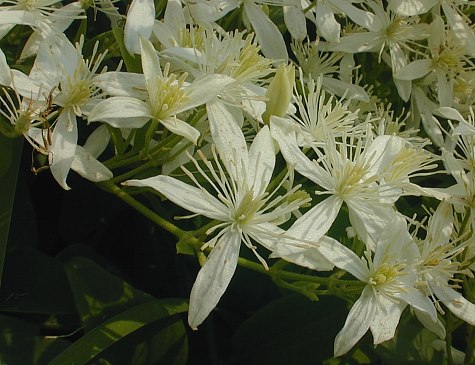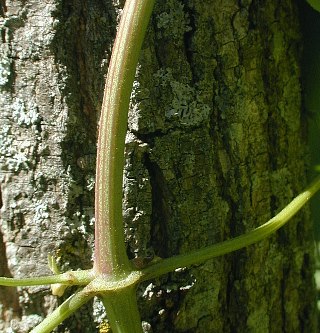Description: This perennial vine is semi-woody and up to 30' long. Young stems are green, glabrous, and terete, while older stems are brownish green to brown. Opposite pairs of compound leaves occur at intervals along the stems. These compound leaves are odd-pinnate and they usually have 5 leaflets. The long petioles of these compound leaves can lean or bend around neighboring objects for support; tendrils are not present. This vine can climb small trees, fences, and similar objects; in more open areas, it sprawls across the ground. The leaflets are up to 3" long and 1½" across; they are ovate or ovate-cordate, glabrous, and smooth along their margins. The upper surface of each leaflet is medium green, while the lower surface is dull light green; its major veins are parallel. Each leaflet has a petiolule (or small stalk) at its base of varying length.

From the axils of
the upper leaves, there develops flat-headed panicles of flowers. The
flowers are usually bisexual, although monoecious vines (with separate
male and female flowers) may occur. Each bisexual flower has 4
petal-like white sepals (less often 5), many long stamens, and 5-6
pistils with elongated styles toward the center. Both the stamens and
styles of the pistils are white or cream-colored. True petals are
absent. The branches and branchlets of the panicle are green and
slender. The blooming period occurs from late summer into fall,
typically lasting about 1½ months. The flowers have a strong sweet
fragrance. After the blooming period, each flower is replaced by a
cluster of achenes with long spreading styles. These persistent styles
are covered with long white hairs, which provides them with a feathery
appearance. The large achenes are ovoid and flattened in shape; they
are thinly covered with appressed silky hairs. Because of their
feathery styles, the achenes are distributed to some extent by the
wind. This perennial vine reproduces by reseeding itself.
Cultivation:
Autumn Clematis thrives in full sun to light shade, moist to slightly
dry conditions, and a loam or clay-loam soil. It also tolerates
gravelly soil and probably sandy soil as well. This vine can smother
small shrubs and is rather aggressive; sometimes it even climbs up the
trunk of trees to occupy the lower branches.

Range & Habitat:
Autumn Clematis has naturalized in widely scattered locations across
Illinois (see Distribution
Map). This vine is undoubtedly more common than official
records indicate, and its abundance within the natural areas of the
state is still growing. Habitats include edges of woodlands, thickets,
fence rows, areas along railroads and roads, and waste land. Autumn
Clematis is native to East Asia and it is often cultivated as an
ornamental plant. This species can be considered somewhat invasive.
Faunal Associations:
The caterpillars of the moths Horisme intestinata
(Brown Bark Carpet), Thyris maculata (Spotted
Thyris), and Thyris sepulchralis (Mournful Thyris)
feed on the foliage of Clematis spp. The
caterpillars of the latter two species are leaf-rollers. There is a
lack of information about floral insect visitors for Autumn Clematis,
but they are probably similar to the visitors of the native Clematis
virginiana (Virgin's Bower). The insect visitors of this
latter species include Halictid bees, various kinds of wasps, and an
abundance of flies. Most of these insects are seeking nectar from the
flowers, although some of them may feed on the pollen or collect it.
Because the foliage of Autumn Clematis is toxic, it is not eaten by
mammalian herbivores.
Photographic Location:
Meadowbrook Park in Urbana, Illinois.

Comments: Like the native Clematis virginiana (Virgin's Bower), Autumn Clematis has showy white flowers. The latter is often found in drier habitats than the former and it blooms later in the year. These two species of Clematis are easy to distinguish: Virgin's Bower has leaflets that are shallowly cleft and dentate, while the leaflet margins of Autumn Clematis are smooth (or nearly so). During the late summer or fall, when the achenes develop, it is also possible to distinguish these species according to their styles: Autumn Clematis has feathery styles, while the styles of Virgin's Bower are more smooth. Other Clematis spp. that occur in natural areas of Illinois have nodding purplish flowers with a very different appearance; they are called 'Leather Flower' vines. Because the leaflets of some Leather Flower vines have smooth margins, it is possible to confuse these species with Autumn Clematis when the flowers are not in bloom. Another scientific name of Autumn Clematis is Clematis dioscoreifolia.